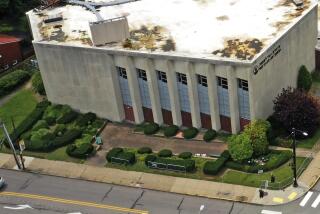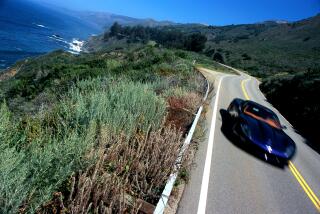Turnpike Parishioners Climb the Stairway to Heaven
- Share via
MILEPOST 129, PENNSYLVANIA TURNPIKE — Look there, at the side of the road. Quickly, or you’ll miss it. On the shoulder of America’s oldest superhighway, upon a mountainous plateau in a place most call nowhere, a concrete staircase leads up, up, up a hillside into the Pennsylvania sky.
You wonder: What is a structure built for feet doing in this most automobile-oriented of realms? Then you drive on at 65 or 70, isolated and intent on your destination. But what if you stopped? What would you find?
A church, it turns out. And a fascinating tale.
For 58 years, this pair of cracked, lonely stairways--one off the eastbound lane, the other across the highway going west--have been most unusual gateways to a Roman Catholic sanctuary and the Catholic community it serves. Its formal name is St. John the Baptist, but to three generations of long-distance drivers who have noticed it and wondered, it goes by a less formal name: The Church on the Turnpike.
And they pull off--truck drivers, traveling Catholics, random passersby, looking for a respite from the lonely ribbon of macadam.
“Most say, ‘I’ve seen this a million times,’ ” said the Rev. Mark Begly, the parish priest. “People say to themselves, ‘I’m going to stop this time and see what’s really going on up there.’ ”
Once there was only quiet on this wind-swept spot, high in the Laurel Mountains about 80 miles east of Pittsburgh.
Michael Riddlemoser, a Baltimore merchant, established a village as a haven for Catholics, some of whom were already there. He called it New Baltimore and envisioned a Carmelite university, but that went to Niagara Falls instead, and St. John the Baptist rose in its place. Then a railroad called the South Penn was supposed to make things happen for New Baltimore, but a power play by financier J.P. Morgan sank those plans.
Then, in 1940, along the route the railroad would have taken, the big road came through--the Pennsylvania Turnpike. It cut through farms, towns, backyards; St. John’s and New Baltimore were in the way.
But an old saying suggests that those traveling faster than the speed of a horse need to stop now and then to let their spirits catch up. So St. John’s and the Turnpike Commission struck an unusual deal: The church agreed to cede the property; in exchange, the turnpike built a pull-off and steps for anyone who wanted to worship.
Now, at milepost 129, three communities intersect: the town of 200 or so souls, the community of the road and, overlooking both, the community of the Lord.
“We welcome outsiders. It’s become part of the tradition,” says Ron Hankinson, the president of New Baltimore’s borough council.
Why do people stop? Curiosity, of course. And Sunday travelers (especially Catholics) can take a break and do their religious duty.
“The service plazas are the commercial oasis. This is the spiritual oasis,” says Dan Cupper, author of a history of the Pennsylvania Turnpike.
But Begly sees something more. There is, in religion and in legend, the image of the traveler--the lonely pilgrim hurrying toward one destination but actually seeking another.
The interstate highway system, disconnects long-distance travelers from their world. And as drivers grow alienated from their environment--especially if they can access it only at sporadic exits--they crave something that nourishes them in a way a rest-stop burger cannot.
“Traveling is a pretty lonely business,” Begly said. “So maybe they come here to get in touch in some deeper way--some small way--with what’s important.”
On the nation’s 5,000 miles of toll road, though St. John’s is quite uncommon, it is becoming less so. Service areas have added ATMs, post offices and even farmers markets. Many airports now offer chapels; can rest stops be far behind?
St. John’s occurred organically. It was there first. “People here have grown up around it,” said Hankinson, a member of one of New Baltimore’s oldest families and a former St. John’s altar boy.
New Baltimore remains isolated from the highway that knocks at its door. Residents who want to get on the turnpike that passes them yards away must drive 20 miles to the nearest on-ramp.
So town and church live in one world and, from the pine-draped hilltop, watch another go by--one that has little to do with them until someone slows down, pulls off and walks up to find something.
“If we’re always on the go, always moving, then we’re not connecting with people in an intimate way over the long haul. And I think that without intimate relationships, we’re all done,” Begly says. “I think people would see church--and this church in particular--as a way of getting in touch with our spiritual home.”
More to Read
Sign up for The Wild
We’ll help you find the best places to hike, bike and run, as well as the perfect silent spots for meditation and yoga.
You may occasionally receive promotional content from the Los Angeles Times.






